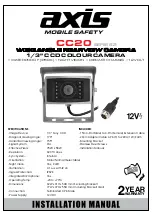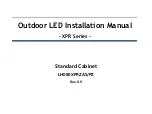
«CamName» User’s Manual
29
DALSA Corp.
03-32-00253-13
Appendix A
EIA-644 Reference
EIA-644 is an electrical specification for the transmission of digital data. The standard is
available from the EIA (Electronic Industries Association). It defines voltage levels,
expected transmission speeds over various cable lengths, common mode voltage
operating requirements for transmitters and receivers, and input impedances and
sensitivities for receivers. The table below gives a quick comparison between EIA-644 and
RS422 (another differential standard).
Table 2. RS422 vs. EIA-644
Parameter
RS422
EIA-644
Differential Driver Output Voltage
±2-5V
±250-450mV
Receiver Input Threshold
±200mV
±100mV
Data Rate
<30Mbps
>400Mbps
Supply Current, Quad Driver (no load, static)*
60mA
3.0mA
Prop. Delay of Driver, max.*
11ns
3ns
Prop. Delay of Receiver, max.*
30ns
5ns
Supply Current, Quad Receiver (no load, static)*
23mA
10mA
* based on National Semiconductor DS90C031/2
The standard requires that two wires (e.g. twisted pair) be used to transmit one signal in a
differential mode. This means that one wire will be logic HIGH while the other wire is
logic LOW. Voltage swing between HIGH and LOW is approximately 350mV, with a
typical offset of approximately 1.25V. The use of differential signal transmission allows
the receiver to reject common mode voltages. This noise rejection improves data integrity
and allows cameras to be installed in an industrial environment.
EIA-644-compatible line receivers and drivers are available from many different IC
manufacturers in a variety of fabrication technologies such as CMOS and GaAs. The EIA-
644 standard does not define specific voltages, so it can migrate from 5V power supplies
to 3.3V and sub-3V. DALSA recommends the use of 5V CMOS line drivers and receivers
such as National Semiconductor parts DS90C031 quad line driver and DS90C032 quad
line receiver.
To achieve full benefit of the common mode rejection, twisted pair cable should be used
for all EIA-644 signals. The cable impedance should be 100 Ohms and the cable
terminated at the receiving end with a 100 Ohm resistor. All EIA-644 inputs in a DALSA
camera are terminated with 100 Ohms between the (+) and (-) of a signal. Figure A-1 (a)
shows an example of an EIA-644 transmission.
DALSA indicates the (+) signal by the name of the signal; i.e. EXSYNC, while the (-)
signal is indicated by either an overscore over the name or appending the letter B to the
end of the name; i.e.
EXSYNC
or EXSYNCB. The (+) signal has the same sense as the TTL
signal which is sent or received; i.e. when EXSYNC in the TTL domain is HIGH then
EXSYNC in the EIA-644 domain is HIGH. The (-) signal has the opposite sense of the TTL
Содержание PIRANHA CL-P1
Страница 5: ... CamName User s Manual 4 DALSA Corp 03 32 00253 13 ...
Страница 23: ... CamName User s Manual 22 DALSA Corp 03 32 00253 13 ...
Страница 29: ... CamName User s Manual 28 DALSA Corp 03 32 00253 13 ...
Страница 33: ... CamName User s Manual 32 DALSA Corp 03 32 00253 13 ...
Страница 35: ... CamName User s Manual 34 DALSA Corp 03 32 00253 13 ...
Страница 37: ... CamName User s Manual 36 DALSA Corp 03 32 00253 13 ...











































